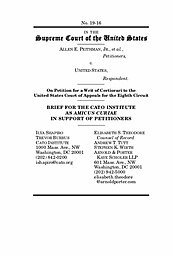Learn more about Cato’s Amicus Briefs Program.
Allen Peithman and his mother owned two “head shops” in Nebraska that sold “potpourri,” a mixture of substances that contained some illegal drugs. They were convicted of selling misbranded “potpourri,” distributing drug paraphernalia, and investing the profits from the illegal sales back into the head shops. After the convictions, the government sought to use criminal forfeiture to take various assets from the defendants. The court eventually determined that $1.1 million was traceable to criminal activity and therefore forfeitable. The court also ruled that Peithman, his mother, and two other defendants were all “jointly and severally liable” for the forfeiture amount, which means that the full amount could be recovered from any defendant.
While criminal forfeiture permits the government to confiscate the assets of those who have been convicted of a crime, there are limits on what types of assets the government can seize. One such limitation comes from the 2017 case of Honeycutt v. United States, when the Supreme Court interpreted a congressional statute to mean that forfeiture is limited to “tainted” assets, meaning property that was directly or indirectly obtained as a result of the crime. The Court explained that, because of this limitation, there could not be joint and several forfeiture liability among co-conspirators. Joint and several liability would allow the government to collect the full liability amount from any co-conspirator, regardless of the role they played in the crime or the proceeds they collected. Such a rule would “by its nature” allow the government to seize “untainted” assets, equal in value to a co-conspirator’s “tainted” assets. But because Peithman and his mother were charged under a different law than the one at issue in Honeycutt, the Eighth Circuit permitted joint and several liability.
Peithman and his co-defendants have appealed their case to the Supreme Court and Cato has filed a brief in support. We ask the Court to take the case and rule that joint and several liability cannot be used in criminal forfeiture. While joint and several liability might make sense in tort law, it does not fit within the framework of criminal law. Not only does the doctrine ignore the fundamental principle of proportionality in criminal sentencing—reflected in the Excessive Fines and Due Process Clauses—it undermines the punitive and remedial purposes of criminal forfeiture by allowing those who actually received the proceeds from a crime to potentially escape having to forfeit their assets while those who did not benefit are forced to give up their assets. Not only this, but the concept of joint and several liability does not comport with the purposes of criminal forfeiture. Criminal forfeiture ensures that the property used in the commission of a crime will not be used again for illegal purposes. Joint and several liability, on the other hand, would allow the government to take property that had nothing to do with the crime.
The Supreme Court should also take this case to ensure that the expansion and abuse of criminal forfeiture statutes does not continue to worsen. Because seized assets are often distributed to law enforcement, there are widespread and egregious abuses of asset forfeiture. Countless people nationwide, and especially those living in poverty, face great financial difficulty after losing their assets to this practice. Because of the harmful effects and the perverse incentives of criminal asset forfeiture, it is up to the courts to police the scope of this practice.

This work is licensed under a Creative Commons Attribution-NonCommercial-ShareAlike 4.0 International License.
